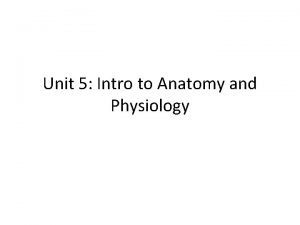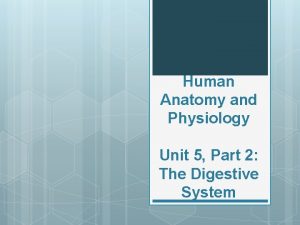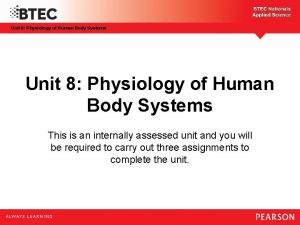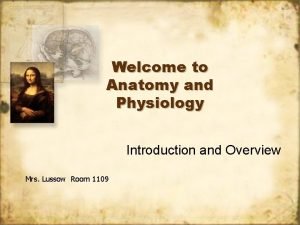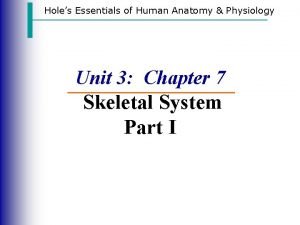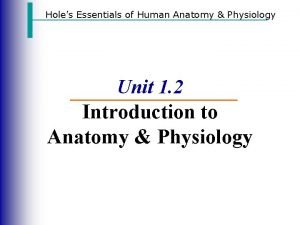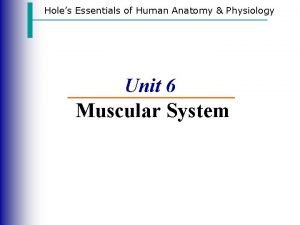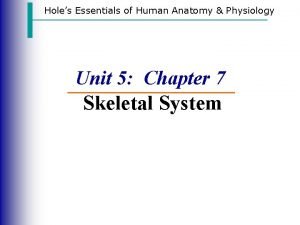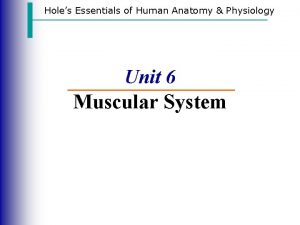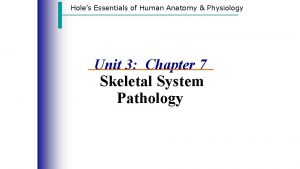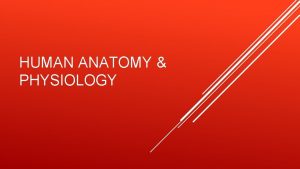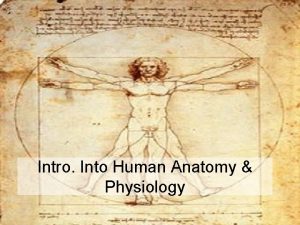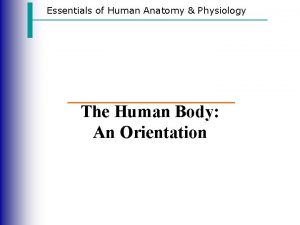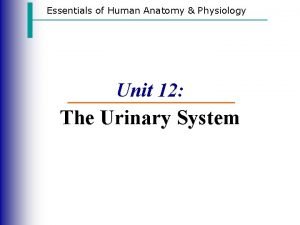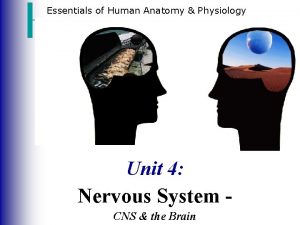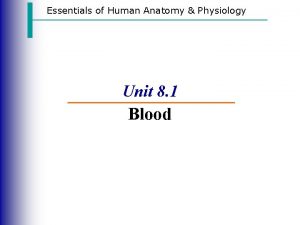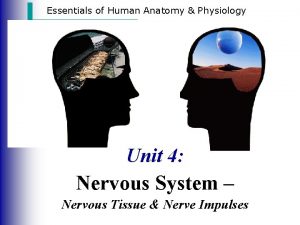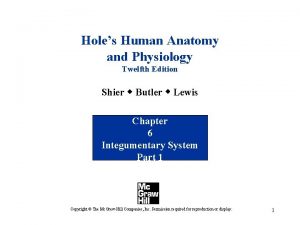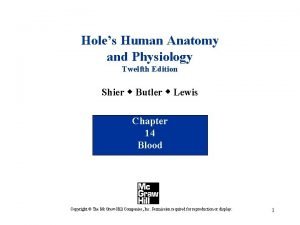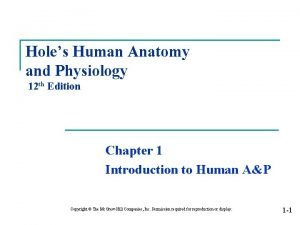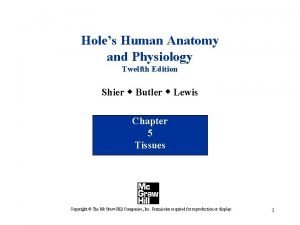Holes Essentials of Human Anatomy Physiology Unit 6




















































- Slides: 52

Hole’s Essentials of Human Anatomy & Physiology Unit 6 Muscular System

Overview of the Muscular System · Three basic muscle types are found in the body · Skeletal muscle · Cardiac muscle · Smooth muscle · Differ in: body location; cell structure; contraction regulation; contraction speed.

Overview of the Muscular System Similarities: 1. Muscle cells are elongated (muscle cell = muscle fiber) 2. Contraction of muscles is due to the movement of protein filaments, called myofilaments, found within the myofibrils of a muscle cell. 3. All muscles share some terminology · Prefix myo refers to muscle · Prefix mys refers to muscle · Prefix sarco refers to flesh example: sarcoplasm cytoplasm of muscle cell sarcolemma cell membrane of muscle cell

Overview of Muscular System Skeletal Muscle Characteristics: 1. Fibers are multinucleate 2. Striated – have visible banding 3. Voluntary – subject to conscious control 4. Most are attached by tendons to bones and bundled by connective tissue 5. Contracts rapidly and vigorously, but tire easily

Overview of Muscular System Cardiac Muscle Characteristics: 1. Found only in the heart 2. Branching, striated cells; contain organized protein filaments similar to skeletal muscle 3. Fibers are uninucleate 4. Involuntary-unconscious control 5. Internal pacemaker– self-excitatory contractions, • Rhythmic contractions that set a steady rate of contraction “pacemaker” 6. Muscle cells are joined at intercalated discs to form junctions that transmit impulses freely & rapidly from cell to cell 7. Contraction reduces internal volume of heart chambers, forcing blood into arteries leaving heart

Overview of Muscular System Smooth Muscle Characteristics: 1. found in walls of hollow visceral organs & blood vessels 2. lacks striations 3. spindle-shaped, arranged in sheets/layers 4. uninucleate cells 5. involuntary control 6. contractions are slow, sustained & rhythmic

Overview of Muscular System Functions: · Produce movement · Locomotion of body as a whole, movement of blood, solids & fluids throughout body · Manipulation · Maintain posture · Fights gravity · Joint stability · Fixators · Generate heat · ¾ of energy of ATP lost as heat

Overview of Muscular System Functional Characteristics of Muscles: · Excitability · Muscles retain the ability to receive and respond to stimuli from the nervous system · Contractility · Muscles shorten upon stimulation · Extensibility · When relaxed, muscles may be stretched · Elasticity · After shortening or stretching, muscles return to original length.

Skeletal Muscle Actions · Skeletal muscles generate a great variety of body movements · Action dependent upon type of joint, and how the muscle is attached to the bones on either side of joint · Muscles are attached to at least two points · Typically one body part is fixed and the other is movable · Origin – attachment to an immoveable bone · Insertion – attachment to a movable bone

Skeletal Muscle Actions · Flexion = decreasing the angle between two bones · Dorsiflexion = decreasing the angle between foot and shin · Plantar flexion = pointing toes · Extension = increasing angle between two bones · Abduction = moving body part away from midline · Adduction = moving body part toward midline · Circumduction = movement in circular motion · Rotation = turning movement of bone about its long axis · Supination = thumbs up · Pronation = thumbs down · Inversion = sole of foot in · Eversion = sole of foot out · Elevation = lifting a body part (shoulder shrug) · Depression = returning a body part to pre – elevated position

Functional Groups of Muscles · Prime mover – muscle with the major responsibility for a certain movement · Biceps brachii · Antagonist – the muscle in opposition to the action of the prime mover; relaxes (or stretches) during the prime movement · Triceps brachii · Synergist – muscle that aids a prime mover in a movement and helps prevent rotation · Brachialis · Fixator – muscle that stabilize the origin of the prime mover (i. e. hold it in place) so that the prime mover can act more efficiently. · Serratus anterior; pectoralis minor

Naming Skeletal Muscles · Skeletal muscles are named based upon a variety of characteristics ranging from shape, size, location and action CHARACTERISTIC TERMS EXAMPLES IN HUMANS Direction of rectus = parallel fascicles relative to transverse = midline perpendicular oblique = at 45 o angle Rectus abdominis Transversus abdominis External Oblique Location (i. e. the frontal bone or body part tibia that a muscle covers) Frontalis Tibialis Anterior Relative Size Gluteus maximus Palmaris longus Peroneus longus maximus = largest longus = longest brevis = shortest

Naming Skeletal Muscles CHARACTERISTIC EXAMPLES IN HUMANS Number of Origins biceps = 2 origins (Heads) triceps = 3 origins Biceps brachii Triceps brachii Shape Deltoid Trapezius Serratus anterior Orbicularis oris deltoid = triangle trapezius = trapezoid serratus = saw-toothed orbicularis = circular Location of Origin origin = sternum and/or Insertion insertion = mastoid process Sternocleidomastoid Action of Muscle Flexor carpi radialis Extensor digitorum Adductor longus flexion extension adduction

Review · What action is described? 1. decreasing the angle between two bones · Flexion 2. decreasing the angle between foot and shin • Dorsiflexion 3. moving body part away from midline • Abduction 4. movement in circular motion • Circumduction 5. thumbs down • Pronation 6. sole of foot out • eversion 7. lifting a body part (shoulder shrug) • Elevation 8. The two points muscles are attached to • Origin and insertion 9. Term for direction of muscle fibers parallel to body’s midline • Rectus 10. A muscle that aids the prime mover in performing the action • synergist

Muscles of Facial Expression

Muscles of Facial Expression NAME OF MUSCLE LOCATION/ DESCRIPTION Epicranius Frontalis Occipitalis Covers cranium over forehead over occipital ACTION elevates eyebrow over forehead, from occipital bone to the skin and muscles around the eyes Orbicularis oris circular muscle around the mouth; Closes, purses the lips (“kissing muscle”) originating near the mouth and inserting to the skin of the lips Zygomaticus O: zygomatic arch I: corners of orbicularis oris muscle that connects zygomatic elevates corners of mouth arch to corner of mouth (“smiling muscle”) muscle that connects zygomatic arch to corner of mouth at the

Muscles of Facial Expression NAME OF MUSCLE LOCATION/ DESCRIPTION Buccinator hollow of cheek compresses cheeks hollow muscle of cheek; “trumpeter’s muscle” originates at the outer surfaces of the upper and lower jaw bones and inserts to the Orbicularis oris Platysma over lower jaw to neck; the fascia in the upper chest anchors the Platysma’s origin and it inserts to the lower border of the mandible depresses mandible Orbicularis oculi circular muscle around eye closes eye circular muscle around eye; originates with the maxillary ACTION

Muscles of Mastication & Head Movement

Muscles of Mastication/Head Movement NAME OF MUSCLE LOCATION/ DESCRIPTION Masseter O: zygomatic arch I: Lateral mandible over lateral mandible elevates mandible Temporalis convergent muscle over temporal bone elevates mandible Sternocleidomastoid O: sternoclavicular region I: mastoid process of temporal bone Major neck muscle flexion of head toward chest (when both contracted) rotation/abduction of head (as antagonists) Splenius capitus **label id and action only Spinous process of lower cervical and upper thoracic vertebrae; also inserts on mastoid process of temporal bone Process of lower cervical and upper thoracic vertebrae Rotates head, bends head to one side, or brings head into an upright position Semispinalis capitus **label id and action only ACTION Extends head, bends head to one side or rotates head

Muscles Moving Pectoral Girdle Posterior view Anterior view

Muscles Moving Pectoral Girdle NAME OF MUSCLE LOCATION/ DESCRIPTION ACTION Trapezius (*) Trapezoid shaped muscle in Rotates scapula and raises Origin: occipital bone & spines posterior neck and upper arm; raises scapula, pulls of C 7 -T 12 back scapula medially or pulls Insertion: clavicle and acromion scapula and shoulder process of scapulae downward Pectoralis minor Serratus anterior “shoulder shrug” Pulls scapula anteriorly and downward or raises ribs Muscle deep to Pectoralis major; originates on the sternal ends of upper ribs and inserts at the coracoid process of the scapula Pulls scapula anteriorly and Saw-toothed lateral thoracic downward muscle; originates at the outer surfaces of the upper ribs and inserts on the ventral surface of scapula

Muscles Moving Pectoral Girdle NAME OF MUSCLE LOCATION/ DESCRIPTION ACTION Rhomboid(eus) major & Rhomboid (eus) minor **label id and action only Takes the shape of a rhombus, deep muscle to the Trapezius originating on the spines of the upper thoracic vertebrae and inserting on the medial border of the scapula A posterior muscle of the scapula and arm attaching to the transverse processes of the cervical vertebrae and inserting on the medial margin of the scapula Raises and adducts scapula Levator scapulae **label id and action only Elevates scapula “shoulder shrug”

Muscles that Move the Arm Anterior view Posterior view

Muscles that Move the Arm

Muscles that Move the Arm NAME OF MUSCLE Pectoralis major (*) Origin: clavicle, sternum, & costal cartilages of ribs 1 -6 Insertion: Greater tubercle of humerus Latissimus dorsi Deltoid LOCATION/ DESCRIPTION Large, convergent chest muscle Large, back muscle Triangular shaped shoulder muscle ACTION flexes arm medially (pull arms forward and together) Pulls arm anteriorly and across chest, rotates humerus, or adducts arm abduction of humerus, extends or flexes the humerus

Muscles that Move the Arm NAME OF MUSCLE LOCATION/ DESCRIPTION Coracobrachialis **label id and action only Originates at the coracoid process of the scapula and inserts on the shaft of the humerus Originates on the posterior surface of the scapula and inserts at the greater tubercle of humerus Originates on the anterior surface of the scapula and inserts at the lesser tubercle of humerus Originates on the posterior surface of the scapula and inserts at the greater tubercle of humerus Lateral border of scapula to the intertubercular groove of Supraspinatus **label id and action only Subscapularis **label id and action only Infraspinatus **label id and action only Teres major **label id and action only ACTION flexes and adducts the arm abducts the arm rotates the arm medially rotates the arm laterally extends the humerus or adducts and rotates arm

Review 1. What muscle is responsible for closing the eye? · Orbicularis oculi 2. What muscle is responsible for abduction of the arm? • deltoid 3. What muscle is responsible for smiling? • zygomaticus 4. What muscles are responsible for chewing? • Masseter and temporalis 5. What muscle is responsible for shrugging? • Trapezoid 6. what is the origin and insertion of the masseter? • O: zygomatic arch; I: lateral mandible 7. What are the fixators of the scapula? • Pectoralis minor and serratus anterior 8. What muscle is responsible for depression of the mandible? • Platysma 9. The frontalis and occipitalis are two parts of what muscle? • epicranius 10. What muscle has its origin at the clavicle, sternum and costal cartilage and its insertion at the greater tubercle of the humerus? • Pectoralis major

Muscles That Move The Forearm

Muscles That Move The Forearm NAME OF MUSCLE LOCATION/ DESCRIPTION Biceps Brachii fusiform, parallel, anterior flexion of arm at upper arm muscle (two elbow (prime mover) origins) O: coracoid process I: radial tuberosity ACTION Brachialis muscle beneath biceps brachii flexion of arm at elbow (synergist) Brachioradialis lateral muscle between upper arm and forearm flexion of arm at elbow (synergist) Triceps brachii posterior upper arm muscle (three heads) extension of arm at elbow

Muscles That Move The Forearm NAME OF MUSCLE LOCATION/ DESCRIPTION Supinator **label id and action only Pronator teres **label id and action only Pronator quadratus **label id and action only ACTION Originates on the lateral epicondyle of the humerus rotates the forearm laterally and crest of ulna and inserts on the lateral surface of the radius rotates forearm Medial epicondyle of medially humerus and coronoid process of ulna to the lateral surface of the radius Anterior distal end of ulna rotates forearm

Muscles That Move The Wrist/Hand/Fingers

Muscles That Move The Wrist/Hand/Fingers

Muscles That Move The Wrist/Hand/Fingers NAME OF MUSCLE LOCATION/ DESCRIPTION Flexor carpi radialis Medial epicondyle of humerus to the base of second and third metacarpals Medial epicondyle of humerus and olecranon process to the carpal and metacarpal bones Medial epicondyle of humerus to the fascia of the palm Flexes the wrist & abduct the wrist Anterior surface of ulna to Flexes fingers **label id and action only Flexor carpi ulnaris **label id and action only Palmaris longus **label id and action only Flexor digitorum (profundus) **label id and action only ACTION Flexes the wrist & Adduct the wrist Flexes the wrist

Muscles That Move The Wrist/Hand/Fingers NAME OF MUSCLE Extensor digitorum **label id and action only LOCATION/ DESCRIPTION Lateral epicondyle of humerus to the posterior surface of phalanges 2 -5 Extensor carpi radialis longus Distal end of humerus to the **label id and action only base of the second metacarpal Extensor carpi radialis brevis **label id and action only Extensor carpi ulnaris **label id and action only Lateral epicondyle of humerus to the base of the second and third metacarpals Lateral epicondyle of ACTION Extends fingers Extends the wrist & Abducts the wrist Extends the wrist & Adducts the wrist

Muscles That Tense The Abdominal Wall

Muscles That Tense The Abdominal Wall NAME OF MUSCLE LOCATION/ DESCRIPTION Rectus abdominis O: pubic crest and symphysis I: xiphoid process and costal cartilages of 5 -7 th ribs strap like muscle from costal cartilages to ilium External Oblique superficial/lateral oblique abdominal muscle Internal Oblique deep oblique abdominal muscle Transversus abdominis deep abdominal muscle that ACTION tenses abdominal wall & compresss abdominal contents; also flexes vertebral column; flex and rotate lumbar region of vertebral column; stabilize pelvis when walking; used in sit-ups/curls tenses abdominal wall & compresss abdominal contents; aid in trunk rotation and lateral flexion (when one side contracts) tenses abdominal wall & compresss abdominal contents; same as Ext. Oblique tenses abdominal wall & compresss abdominal

Muscle review: What do you know?

Name the muscles: 1. 2. 3. 4. 5. 6. 1. Frontalis 2. Orbicularis oculi 7. 3. Zygomaticus 4. Buccinator 8. 5. Orbicularis oris 6. Platysma 7. Temporalis 9. 8. Occipitalis 10. 9. Masseter 10. Sternocleido mastoid 11. Trapezoid

Origin and insertion: Zygomaticus O: zygomatic arch I: corners of orbicularis oris Masseter O: zygomatic arch I: Lateral mandible Sternocleidomastoid O: sternoclavicular region I: mastoid process of temporal bone

Name the muscles 1. Trapezius 2. Deltoid 3. Latissimus dorsi 4. Pectoralis minor 5. Serratus anterior 1. Origin and insertion: Trapezius O: occipital bone and spines C 7 -T 12 I: Clavicle and acromion process of scapula 4. 2. 5. 3.

Name the muscles: 1. 2. 3. 4. 5. Deltoid Pectoralis major Biceps brachii Brachialis Brachioradialis 1. Origin and Insertion: Biceps Brachii O: coracoid process I: radial tuberosity Pectoralis major O: clavicle, sternum and costal cartilage of ribs 1 -6 I: greater tubercle of humerus 2. 3. 4. 5.

Name the muscles: 1. Triceps brachii 2. Biceps brachii 3. Brachialis 4. Brachioradialis 5. Flexor carpi radialis 6. Triceps brachii 7. Extensor carpi radialis 8. Flexor carpi ulnaris 9. Extensor carpi ulnaris 10. Extensor digitorum 1. 2. 3. 4. 5. 6. 7. 8. 9. 10.

Name the muscles: 1. 2. 3. 4. 5. 6. 7. 8. Sternocleidomastoid Deltoid Pectoralis major (external intercostals) Rectus abdominus External obliques Internal obliques Transversus abdominus 6. 7. 8. Origin and insertion: Rectus abdominis O: pubic crest and symphysis I: xiphoid process and costal cartilages of 57 th ribs

Muscles That Move Thigh Adductor longus

Muscles That Move Thigh NAME OF MUSCLE LOCATION/ DESCRIPTION Gluteus maximus (*) Origin: posterior ilium, sacrum, coccyx Insertion: posterior femur and fascia of thigh Gluteus medius buttocks, largest muscle in body Extensor of thigh lateral hip muscle; lateral surface of ilium to the greater trochanter of femur Lateral hip muscle; lateral surface of ilium to the greater trochanter of femur Anterior iliac crest to the fascia of the thigh Abducts and rotates the thigh medially Gluteus minimus **label id and action only Tensor fasciae latae **label id and action only ACTION Abducts and rotates the thigh medially Abducts, flexes, and rotates thigh medially; steadies the knee and trunk on thigh by making iliotibial tract taut

Muscles That Move Thigh NAME OF MUSCLE LOCATION/ DESCRIPTION Adductor longus medial thigh muscle from pubic bone near the symphysis pubis to the posterior surface of the femur begins at the ischial tuberosity and inserts on the posterior surface of the femur Adductor magnus **label id and action only Psoas major **label id and action only Iliacus **label id and action only ACTION Adducts, flexes, and rotates thigh laterally Adducts, extends, and rotates thigh laterally Lumbar intervertebral discs, Flexes thigh bodies and transverse processes of lumbar vertebrae to the lesser trochanter of femur Iliac fossa of ilium to the Flexes thigh lesser trochanter of femur Lower edge of symphysis Adducts thigh, flexes and

Muscles That Move the Leg

Muscles That Move the Leg NAME OF MUSCLE LOCATION/ DESCRIPTION ACTION Rectus femoris anterior thigh; quadricep extension of leg at knee Vastus lateralis lateral anterior thigh; quadriceps extension of leg at knee Vastus medialis medial anterior thigh; quadriceps extension of leg at knee Vastus intermedius deep anterior thigh; quadriceps extension of leg at knee

Muscles That Move the Leg NAME OF MUSCLE LOCATION/ DESCRIPTION Sartorius O: iliac spine I: medial tibia parallel straplike muscle that crosses thigh “Tailors muscle” Biceps femoris posterior thigh; hamstring Semitendinosus posterior thigh; hamstring; ischial tuberosity to medial surface of tibia posterior thigh; hamstring; ischial Semimembranosus ACTION flexion of knee and thigh forward; abducts the thigh; rotates thigh laterally; rates leg medially flexion of leg at knee; extends thigh

Muscles That Move The Foot & Toes

Muscles That Move The Foot & Toes NAME OF MUSCLE Tibialis anterior Fibularis longus Gastrocnemius O: condyles of femur I: calcaneus Soleus LOCATION/ DESCRIPTION ACTION anterior to tibia Dorsiflexion lateral to fibula; Eversion important to supporting arch since it inserts at the tarsal and metatarsal bones from the lateral condyle of the tibia and the head/shaft of the fibula posterior lower leg (i. e. plantar flexion (prime calf muscle); two origins deep to gastrocnemius mover) plantar flexion (synergist)

Muscles That Move The Foot & Toes NAME OF MUSCLE LOCATION/ DESCRIPTION ACTION Fibularis tertius Third fibularis muscle most Dorsiflexion and eversion **label id and action only easily identified posterior to of foot the extensor digitorum longus below the ankle’s transverse fascia Extensor digitorum longus Lateral condyle of tibia and Dorsiflexion and eversion **label id and action only anterior surface of fibula of foot and extension of with insertion on the dorsal toes surfaces of the second and third phalanges of the four lateral toes Flexor digitorum longus Posterior surface of tibia Plantar flexion and **label id and action only with insertion on the distal inversion of foot, and phalanges of the four lateral flextion of hte four lateral
 Holes essential of human anatomy and physiology
Holes essential of human anatomy and physiology Holes anatomy and physiology chapter 1
Holes anatomy and physiology chapter 1 Endomysium
Endomysium Chapter 1 introduction to human anatomy and physiology
Chapter 1 introduction to human anatomy and physiology Chapter 1 introduction to anatomy and physiology
Chapter 1 introduction to anatomy and physiology Chapter 2 human reproductive anatomy and physiology
Chapter 2 human reproductive anatomy and physiology Human anatomy and physiology 10th edition
Human anatomy and physiology 10th edition Human anatomy & physiology edition 9
Human anatomy & physiology edition 9 Unit 26 self evaluation answers
Unit 26 self evaluation answers Anatomy and physiology unit 7 cardiovascular system
Anatomy and physiology unit 7 cardiovascular system Unit 26 animal anatomy physiology and nutrition
Unit 26 animal anatomy physiology and nutrition Horizontal anatomical plane
Horizontal anatomical plane Lamina propria
Lamina propria Unit 8: physiology of human body systems assignment 1
Unit 8: physiology of human body systems assignment 1 Upper respiratory system labeled
Upper respiratory system labeled Tattoo anatomy and physiology
Tattoo anatomy and physiology Anatomy science olympiad
Anatomy science olympiad Structure anatomy and physiology in agriculture
Structure anatomy and physiology in agriculture Anatomy and physiology bones
Anatomy and physiology bones Anatomy and physiology of peptic ulcer ppt
Anatomy and physiology of peptic ulcer ppt Cantlie line
Cantlie line Epigastric region
Epigastric region Iliac regions
Iliac regions Google.com
Google.com The central sulcus divides which two lobes? (figure 14-13)
The central sulcus divides which two lobes? (figure 14-13) Http://anatomy and physiology
Http://anatomy and physiology Appendicitis anatomy and physiology
Appendicitis anatomy and physiology Aohs foundations of anatomy and physiology 1
Aohs foundations of anatomy and physiology 1 Aohs foundations of anatomy and physiology 2
Aohs foundations of anatomy and physiology 2 Anatomical planes
Anatomical planes Anatomy and physiology chapter 8 special senses
Anatomy and physiology chapter 8 special senses Chapter 13 anatomy and physiology of pregnancy
Chapter 13 anatomy and physiology of pregnancy Science olympiad forensics cheat sheet
Science olympiad forensics cheat sheet Chapter 2 basic chemistry anatomy and physiology
Chapter 2 basic chemistry anatomy and physiology Anatomy and physiology of stomach ppt
Anatomy and physiology of stomach ppt Anatomy and physiology of pancreas in diabetes
Anatomy and physiology of pancreas in diabetes Chapter 7 anatomy and physiology
Chapter 7 anatomy and physiology Anatomy and physiology coloring workbook chapter 14
Anatomy and physiology coloring workbook chapter 14 Chapter 10 blood anatomy and physiology
Chapter 10 blood anatomy and physiology Aohs foundations of anatomy and physiology 1
Aohs foundations of anatomy and physiology 1 Aohs foundations of anatomy and physiology 1
Aohs foundations of anatomy and physiology 1 Anatomy and physiology
Anatomy and physiology Anatomy and physiology chapter 15
Anatomy and physiology chapter 15 Cornell notes for anatomy and physiology
Cornell notes for anatomy and physiology Anatomy and physiology chapter 1
Anatomy and physiology chapter 1 Anatomy and physiology chapter 15
Anatomy and physiology chapter 15 Anatomy and physiology
Anatomy and physiology Aohs foundations of anatomy and physiology 1
Aohs foundations of anatomy and physiology 1 Aohs foundations of anatomy and physiology 1
Aohs foundations of anatomy and physiology 1 2012 pearson education inc anatomy and physiology
2012 pearson education inc anatomy and physiology Human physiology exam 1
Human physiology exam 1 Welcome to anatomy and physiology
Welcome to anatomy and physiology Physiology of the foot and ankle
Physiology of the foot and ankle











